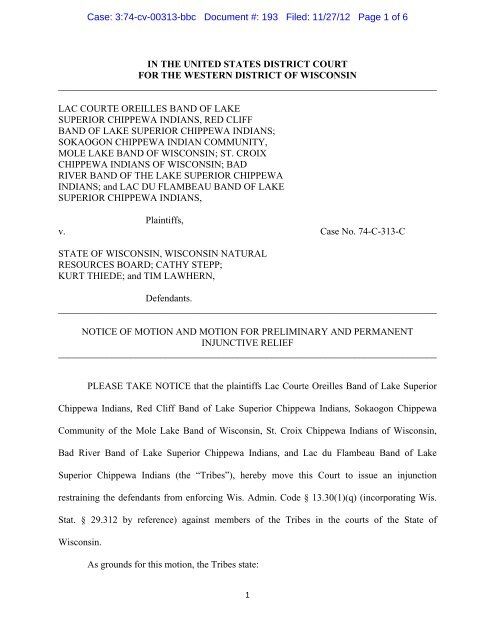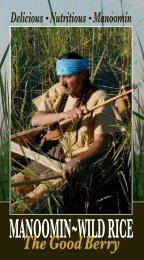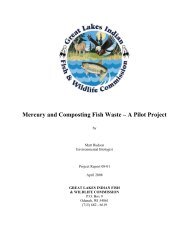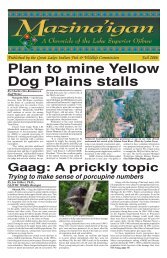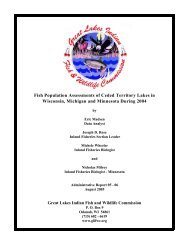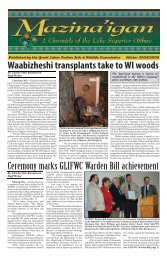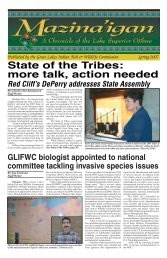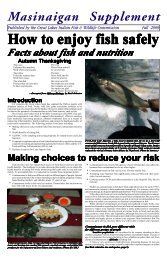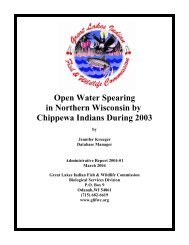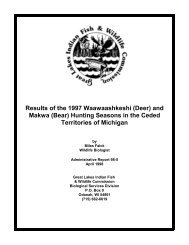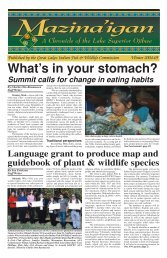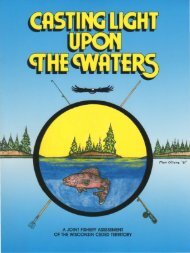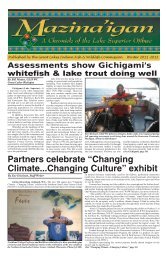Plaintiff Motion for Preliminary Injunction - Great Lakes Indian Fish ...
Plaintiff Motion for Preliminary Injunction - Great Lakes Indian Fish ...
Plaintiff Motion for Preliminary Injunction - Great Lakes Indian Fish ...
Create successful ePaper yourself
Turn your PDF publications into a flip-book with our unique Google optimized e-Paper software.
Case: 3:74-cv-00313-bbc Document #: 193 Filed: 11/27/12 Page 1 of 6<br />
IN THE UNITED STATES DISTRICT COURT<br />
FOR THE WESTERN DISTRICT OF WISCONSIN<br />
______________________________________________________________________________<br />
LAC COURTE OREILLES BAND OF LAKE<br />
SUPERIOR CHIPPEWA INDIANS, RED CLIFF<br />
BAND OF LAKE SUPERIOR CHIPPEWA INDIANS;<br />
SOKAOGON CHIPPEWA INDIAN COMMUNITY,<br />
MOLE LAKE BAND OF WISCONSIN; ST. CROIX<br />
CHIPPEWA INDIANS OF WISCONSIN; BAD<br />
RIVER BAND OF THE LAKE SUPERIOR CHIPPEWA<br />
INDIANS; and LAC DU FLAMBEAU BAND OF LAKE<br />
SUPERIOR CHIPPEWA INDIANS,<br />
<strong>Plaintiff</strong>s,<br />
v. Case No. 74-C-313-C<br />
STATE OF WISCONSIN, WISCONSIN NATURAL<br />
RESOURCES BOARD; CATHY STEPP;<br />
KURT THIEDE; and TIM LAWHERN,<br />
Defendants.<br />
______________________________________________________________________________<br />
NOTICE OF MOTION AND MOTION FOR PRELIMINARY AND PERMANENT<br />
INJUNCTIVE RELIEF<br />
______________________________________________________________________________<br />
PLEASE TAKE NOTICE that the plaintiffs Lac Courte Oreilles Band of Lake Superior<br />
Chippewa <strong>Indian</strong>s, Red Cliff Band of Lake Superior Chippewa <strong>Indian</strong>s, Sokaogon Chippewa<br />
Community of the Mole Lake Band of Wisconsin, St. Croix Chippewa <strong>Indian</strong>s of Wisconsin,<br />
Bad River Band of Lake Superior Chippewa <strong>Indian</strong>s, and Lac du Flambeau Band of Lake<br />
Superior Chippewa <strong>Indian</strong>s (the “Tribes”), hereby move this Court to issue an injunction<br />
restraining the defendants from en<strong>for</strong>cing Wis. Admin. Code § 13.30(1)(q) (incorporating Wis.<br />
Stat. § 29.312 by reference) against members of the Tribes in the courts of the State of<br />
Wisconsin.<br />
As grounds <strong>for</strong> this motion, the Tribes state:<br />
1
Case: 3:74-cv-00313-bbc Document #: 193 Filed: 11/27/12 Page 2 of 6<br />
1. In Lac Courte Oreilles Band of <strong>Indian</strong>s v. Wisconsin, 740 F.Supp. 1400 (W.D.<br />
Wis. 1990) (LCO VII), this Court held that hunting deer at night posed a “great danger . . . to<br />
public safety,” and there<strong>for</strong>e, the defendants were allowed to en<strong>for</strong>ce the State prohibition on<br />
shining of deer contained in § NR 13.30(1)(q) until the Tribes adopted regulations identical in<br />
scope and content to § NR 13.30(1)(q).<br />
2. Shortly after the decision in LCO VII, the Tribes amended § 6.1 of the Model Off-<br />
Reservation Conservation Code (Model Code) to prohibit deer shining in a manner that was<br />
identical in scope and content to § NR 13.30(1)(q). This section of the Model Code is still in<br />
effect today, and precludes the State from en<strong>for</strong>cing § NR 13.30(1)(q) against Tribal members.<br />
3. In 2001, the parties submitted a joint motion to this Court requesting modification<br />
of the final judgment entered in Lac Courte Oreilles Band v. Wisconsin, 775 F.Supp. 321 (W.D.<br />
Wis. 1991) (LCO X). See Exhibit 16. In doing so, the parties acknowledged that “new<br />
in<strong>for</strong>mation, new data, or other changes in circumstances” may render some regulations<br />
previously approved by the Court “unnecessary <strong>for</strong> health, safety, or conservation purposes.” Id.<br />
at 3. The parties asked that the Court allow modifications to the stipulations and revisions to<br />
the Tribes’ Model Code to be made by the parties’ mutual consent.<br />
4. On June 13, 2001, this Court granted the parties’ motion under Federal Rules of<br />
Civil Procedure 60(b)(6). Exhibit 15. Since that time, the parties have submitted two<br />
amendments to the Court that modify the final judgment in LCO X.<br />
5. In the 2009 Stipulation <strong>for</strong> Technical, Management, and Other Updates: First<br />
Amendment of Stipulations Incorporated into Final Judgment, the parties agreed that the<br />
Executive Administrator of GLIFWC could, “without consultation with the State, issue a<br />
2
Case: 3:74-cv-00313-bbc Document #: 193 Filed: 11/27/12 Page 3 of 6<br />
Commission Order to provide tribal members more treaty harvest opportunities in line with<br />
opportunities provided under State law to non-members of the plaintiff Tribes.” Exhibit 14 at §<br />
V(2)(a). This amendment procedure is referred to by the parties as the “technical amendment”<br />
process.<br />
6. In the 2011 Stipulation <strong>for</strong> Technical, Management, and Other Updates: Second<br />
Amendment of Stipulations Incorporated Into Final Judgment, the parties agreed that the<br />
Executive Administrator of GLIFWC could, “after consultation with the State and upon<br />
agreement of the parties (where consent may not be unreasonably withheld), issue a Commission<br />
Order to provide tribal members more treaty harvest opportunities consistent with those available<br />
under state law to state harvesters.” Exhibit 5 at § III(A)(2). This amendment process is referred<br />
to by the parties as the “other liberalization amendment” process.<br />
7. In 2002, the State of Wisconsin first discovered that chronic wasting disease<br />
(CWD) had infected deer in the southern portion of the State. While CWD poses no threat to the<br />
human population, it may produce dramatic declines in the deer population if not checked.<br />
Currently, there are no available treatments or vaccines <strong>for</strong> CWD.<br />
8. Beginning in 2002 and continuing until at least 2011, the Wisconsin Department<br />
of Natural Resources (Department) used sharpshooters to shoot deer in locations where CWD<br />
was thought to be present. These sharpshooters were authorized to and did shoot deer at night<br />
<strong>for</strong> at least ten years.<br />
9. Wisconsin is not the only state to use nighttime sharpshooters to cull the local<br />
deer population. In recent years, nighttime shooting of deer has become commonplace around<br />
the country, including in urban and suburban settings, because it is a safe and effective way of<br />
lowering or eliminating the deer population in an area.<br />
3
Case: 3:74-cv-00313-bbc Document #: 193 Filed: 11/27/12 Page 4 of 6<br />
10. In 2012, the Wisconsin Legislature authorized a nighttime wolf hunt open to the<br />
general public that begins on November 26, 2012 and runs through February 28, 2013. 2011<br />
Wis. Act 169, Exhibit 17. On July 2, 2012, the Wisconsin Natural Resource Board approved<br />
Board Order WM-09-12E, which establishes the rules governing this year’s wolf hunt. These<br />
rules provide that the holder of a wolf permit may hunt at night if they: (1) use calling<br />
techniques or bait the site; (2) shoot from a stationary position; and (3) do not use dogs. Exhibit<br />
24.<br />
11. Wolves are substantially larger than coyotes. As a result, most persons shooting<br />
wolves in Wisconsin will or should use high caliber cartridges – including the same cartridges<br />
used <strong>for</strong> killing deer – when shooting wolves.<br />
12. In response to these changes in State law, the Tribes initiated good faith<br />
consultation with the State in an attempt to gain the State’s consent to nighttime deer hunting by<br />
Tribal members within the ceded territory. Consultation was initiated in the spring of 2012, and<br />
continued through mid-November 2012.<br />
13. During consultation sessions, the State at first indicated that it had no objection to<br />
Tribal night hunting of deer. Later, the State changed its position, and requested that the Tribes<br />
delay implementation of any change until next year, because it would likely create negative<br />
publicity. Only at the eleventh hour did the State raise safety concerns with the Tribes’ proposal.<br />
Those concerns are meritless and discriminatory, and the State’s refusal to consent to the change<br />
in Tribal laws is there<strong>for</strong>e unreasonable.<br />
14. On November 21, 2012, the <strong>Great</strong> <strong>Lakes</strong> <strong>Indian</strong> <strong>Fish</strong> and Wildlife Commission<br />
(GLIFWC) issued Commission Order No. 2012-05. Exhibit 25. This Order carves out an<br />
exception to the ban on nighttime hunting of deer. It permits Tribal members to obtain a permit<br />
4
Case: 3:74-cv-00313-bbc Document #: 193 Filed: 11/27/12 Page 5 of 6<br />
to shoot deer at night if they can satisfy certain stringent requirements, which include but are not<br />
limited to: (1) receiving marksmanship training and a marksmanship proficiency rating from<br />
their tribe, the U.S. armed <strong>for</strong>ces, or a law en<strong>for</strong>cement agency; (2) completing an advanced<br />
hunter safety course; (3) creating a shooting plan that will be carried with them on any nighttime<br />
hunts and will be entered into a database that can be accessed by the Conservation En<strong>for</strong>cement<br />
Division in the field; (4) designating their “safe zone of fire,” which requires members to<br />
preselect their “point of kill” and to ensure that there is an adequate backstop to catch any errant<br />
bullets; and (5) shooting from a stationary position.<br />
15. The requirements <strong>for</strong> nighttime hunting contained in Commission Order No.<br />
2012-05 were initially modeled after the requirements <strong>for</strong> the State’s own nighttime CWD<br />
eradication program, and as enacted, are even more stringent than the State rules.<br />
16. The Commission’s Order was validly issued pursuant to the “other liberalization<br />
amendment” procedures contained in the Stipulation <strong>for</strong> Technical, Management and Other<br />
Updates: Second Amendment of the Stipulations Incorporated in the Final Judgment, because<br />
the State’s consent was unreasonably withheld.<br />
17. Alternatively, this Court should grant the Tribes relief from the final judgment in<br />
LCO X under Federal Rules of Civil Procedure 60(b)(5), because the Tribes have demonstrated a<br />
“significant change in circumstances warrants revision of the decree,” and that the proposed<br />
modification “is suitably tailored to the changed circumstance.” Rufo v. Inmates of Suffolk Cnty.<br />
Jail, 502 U.S. 367, 383 (1992).<br />
18. This Court should issue a preliminary injunction restraining the defendants from<br />
en<strong>for</strong>cing Wis. Admin. Code § 13.30(1)(q) against members of the Tribes in the courts of the<br />
State of Wisconsin while these proceedings are pending.<br />
5
Case: 3:74-cv-00313-bbc Document #: 193 Filed: 11/27/12 Page 6 of 6<br />
19. After providing an opportunity <strong>for</strong> the parties to engage in limited discovery and<br />
after the holding of an evidentiary hearing, this Court should issue a permanent injunction<br />
restraining the defendants from en<strong>for</strong>cing Wis. Admin. Code § 13.30(1)(q) against members of<br />
the Tribes in the courts of the State of Wisconsin.<br />
Respectfully submitted this 27 th day of<br />
November, 2012<br />
/s/ Colette Routel<br />
Associate Professor<br />
William Mitchell College of Law<br />
875 Summit Avenue<br />
Saint Paul, MN 55105<br />
(651) 290-6327<br />
colette.routel@wmitchell.edu<br />
Attorney <strong>for</strong> Lac du Flambeau Band<br />
James H. Schlender, Jr.<br />
Attorney <strong>for</strong> Lac Courte Oreilles Band of<br />
Lake Superior Chippewa <strong>Indian</strong>s<br />
Milt Rosenberg<br />
Attorney <strong>for</strong> Red Cliff Band of Lake<br />
Superior Chippewa <strong>Indian</strong>s<br />
Wade Williams<br />
Attorney <strong>for</strong><br />
Sokaogon Chippewa Community,<br />
Mole Lake Band<br />
Aaron Loomis<br />
Attorney <strong>for</strong> St. Croix Chippewa <strong>Indian</strong>s of<br />
Wisconsin<br />
Erick Arnold<br />
Attorney <strong>for</strong> Bad River Band of Lake<br />
Superior Chippewa <strong>Indian</strong>s<br />
6


